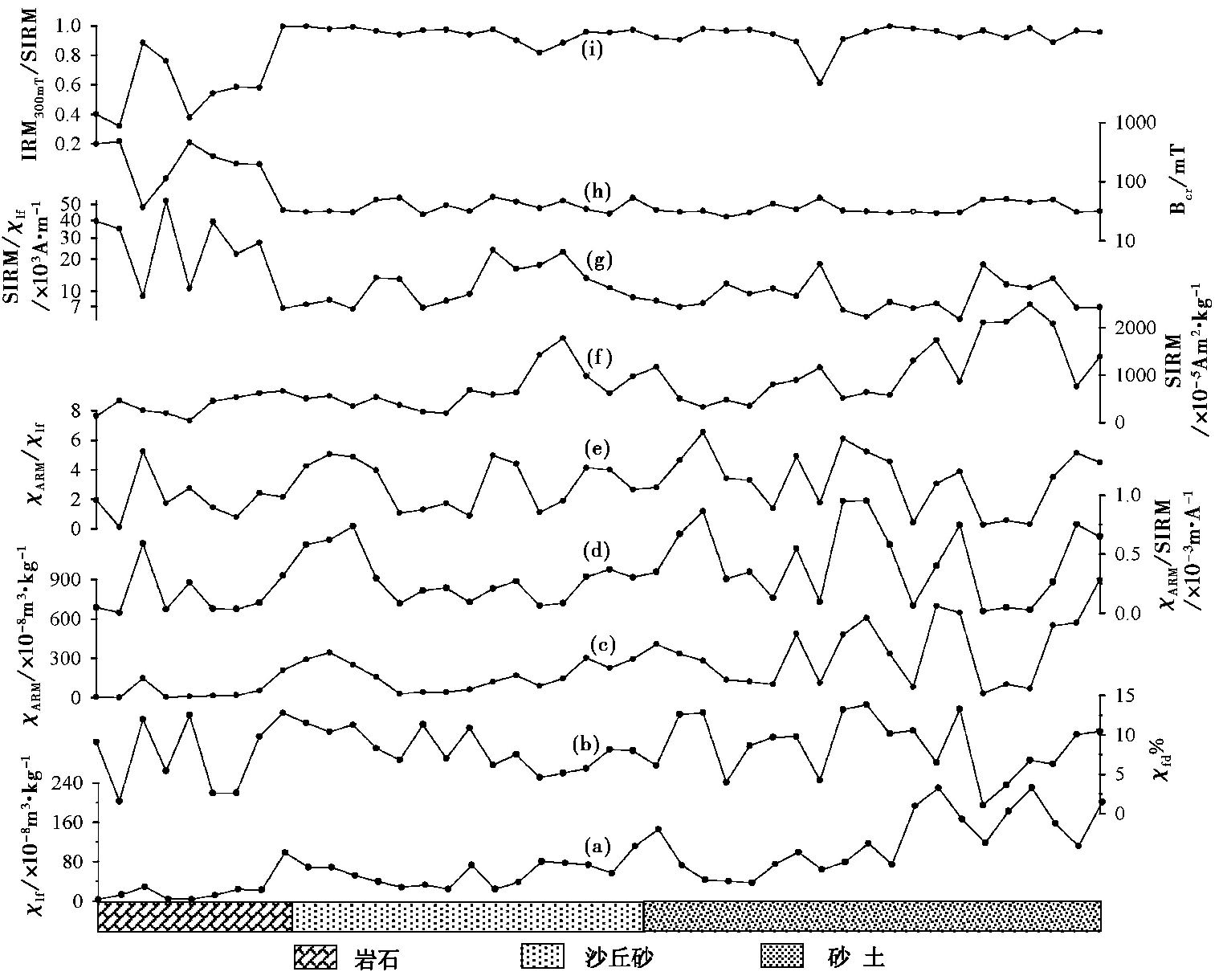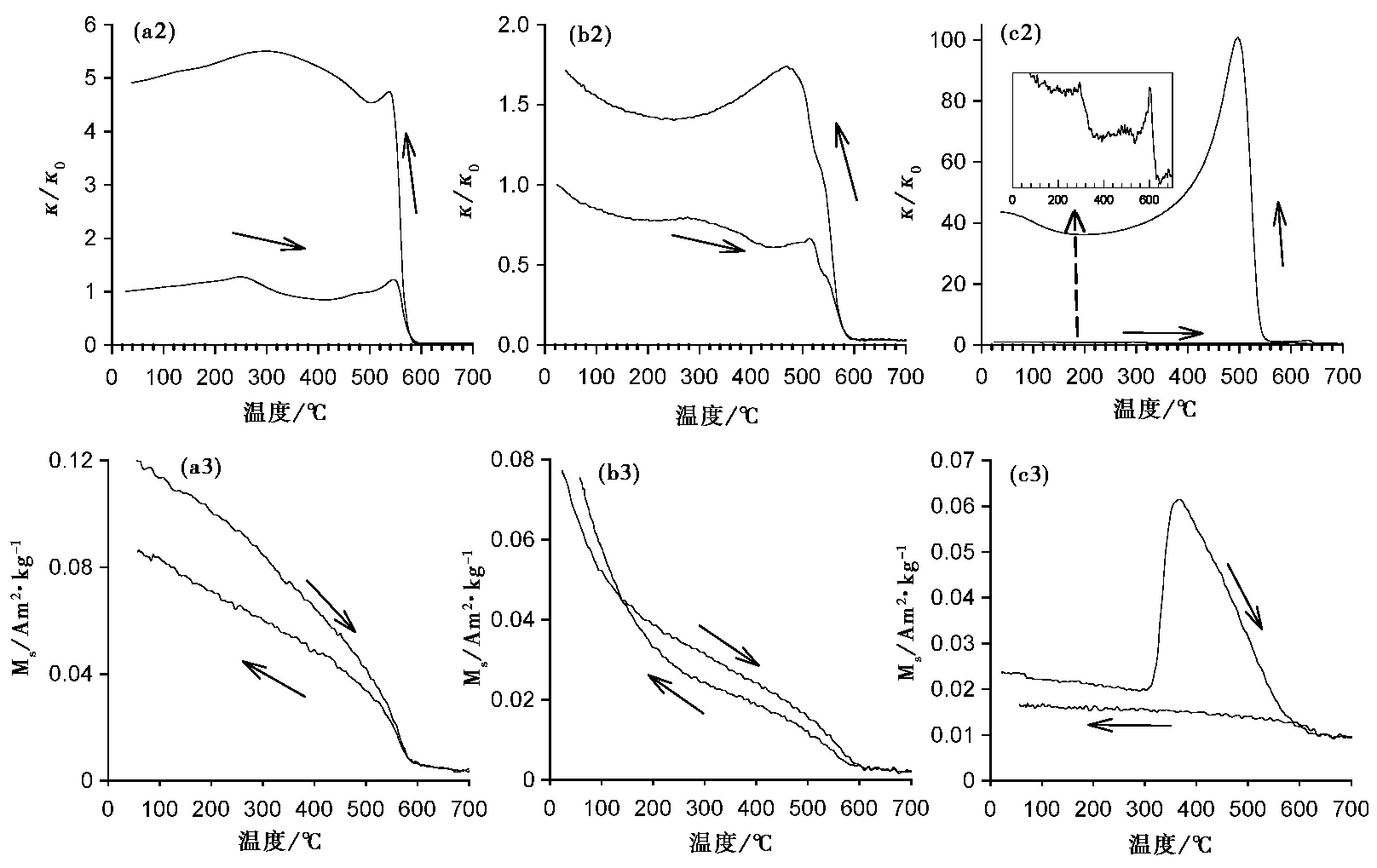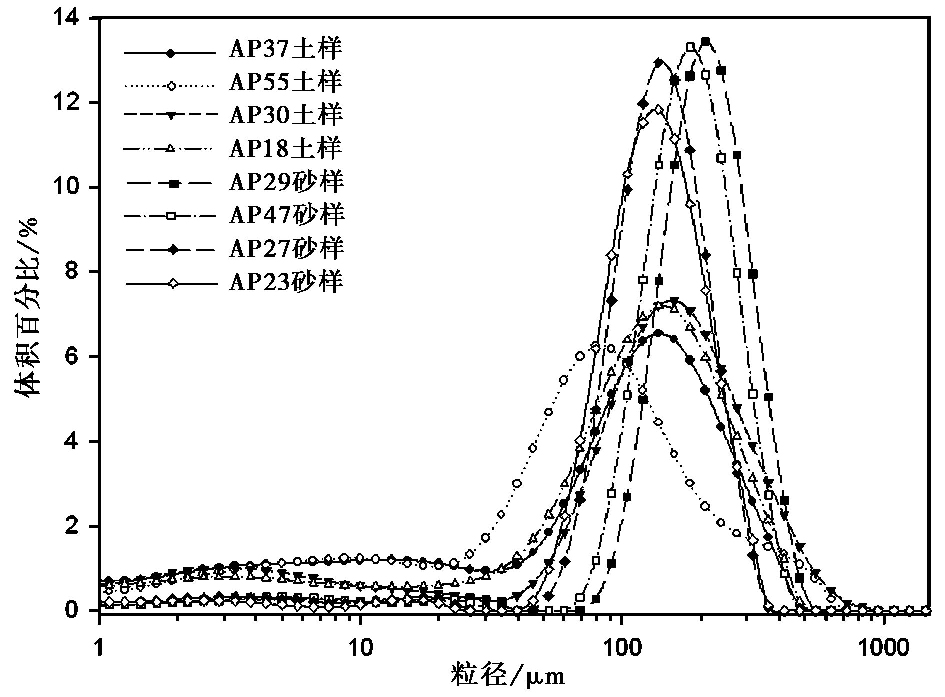② 福建师范大学地理研究所, 福州 350007; Department of Environment and Geography, Macquarie University, Sydney NSW 2109, Australia)
1 引言
以磁化率为主的磁学参数作为代用指标不仅普遍地应用于黄土古气候研究[1, 2, 3, 4, 5, 6, 7, 8, 9, 10, 11],同时在国内外其他不同环境和不同类型沉积物(包括风尘沉积物、 海洋沉积物和湖泊沉积物)的研究中也受到广泛关注,对于揭示古地理环境变化发挥着重要作用[12, 13, 14, 15, 16, 17, 18, 19, 20, 21, 22, 23, 24, 25, 26, 27]。现代土壤、 沙漠特征及气候背景是了解黄土沉积过程及古气候状况最直接的见证[28]; 土壤表层磁化率增强现象也有助于探索磁性矿物的生成转化机制。然而风积物磁化率的指示意义存在多解性[29, 30],一定程度上限制了人们对古气候古环境变化的理解。当前表土磁学主要围绕物源和气候条件非常相似的黄土高原及其周围地区开展了一些研究工作[31, 32, 33, 34, 35],不利于多角度研究土壤磁性与环境之间的关系。风积物广泛分布于干旱半干旱区,选择不同气候和地理环境下的表土样品进行对比研究是未来探索土壤磁学性质和环境间关系的一个重要方面[36]。对于中国黄土高原地区,无论黄土-古土壤剖面研究还是表土研究,降水量都是频率磁化率变化的主要控制因素: 更高的降水量促进土壤发育,导致频率磁化率升高[31, 35, 37, 38]。影响土壤发育的气候因素众多,但温度作为引起土壤磁性特征变化不可或缺的要素却得到较少的关注和研究。为此,选择年均降水量与兰州相当,而气温与黄土高原地区存在明显差别的澳大利亚中部Alice Spring地区开展表土研究。基于二者同为风尘沉积的干旱半干旱区,将其磁学特征与中国黄土高原表土进行对比分析,以期探讨不同性质和不同沉积环境下表土磁学特征及变化规律。试图根据澳大利亚中部红色表土所蕴含的环境意义,将今论古分析沉积古地理环境。
2 材料与方法样品采自澳大利亚中部的Alice Spring及附近区域( 图1),该区经纬度(23°42′177″~25°20′534″S, 130°44′411″~133°53′098″E) 为南半球亚热带地区,地势起伏小,周围多沙漠,是世界四大沙尘暴中心之一[39],是风尘沉积的重要区域[40]。气象观测站数据显示,该区年均降水量300mm左右,年均气温20.8℃[41],为典型的半干旱区,集中降水和高温同期出现。目前对澳大利亚这一特殊气候条件下黄土沉积的报道不足[42, 43]。该区地表呈单一红色( 图2a),与中国干旱半干旱区和世界其他沙漠黄色表土差异明显。

|
图 1 研究区示意图 Fig.1 Sketch map of the sampling sites |

|
图 2 采样区红色地表特征 (a)红色残留岩丘和洪积盆地(red monadnock and pluvial basin);(b)岩石新鲜面(fresh face of the rock); (c)砂土采样点(sampling site of sandy);(d)沙丘砂采样点(sampling site of dune sand);(e)岩石采样点(sampling site of bed rock) Fig.2 Red surface feature of the research area |
采样路线及采样点如 图1所示。自Alice Spring出发,沿公路经Kings Creek、 Ayer Rock 等地返回Alice Spring。样品为地表直接采样,厚度约2~5cm。采样点远离居民点以减少人为因素影响。共采集44个地表样品,按照岩性差异,样品共分三类: 分别是地表砂土样(20个)、 沙丘砂样(15个)和岩石样(9个)( 图2c、 2d和2e)。砂土是从地表红色坡积物或者洪积物中剔除粗大砾石后所得,因为粗大砾石受沉积之后的环境影响小,而细粒部分的矿物组成与其所对应的气候条件密切相关; 岩石采样主要选择一些具有红颜色的岩石露头采集。
样品放置于实验室自然晾干,称重后再用塑料膜包紧压实,放入无磁性样品盒。低频(470Hz)磁化率(χlf)和高频(4700Hz)磁化率(χhf)用Bartington-MS2型磁化率仪进行测量,并计算百分比频率磁化率(χfd % =100 % ×(χlf-χhf)/χlf)。使用D-2000交变退磁仪(0.1档)和Molspin Minispin小旋转磁力仪测量非磁滞剩磁(ARM),交变场峰值为100mT,直流场为50μT,计算出非磁滞磁化率(χARM),计算公式为ARM/H(H为直流场值)。样品的等温剩磁(IRM)和饱和等温剩磁(SIRM=IRM1000mT)用ASC IM-10-30脉冲磁力仪和Molspin Minispin小旋转磁力仪获得。样品饱和后,以10mT为间距施加反向磁场,使剩磁减小为负值,并计算出剩磁矫顽力(Bcr)。此外,使用VFTB(variable field transition balance)居里秤测量部分样品的热磁曲线(Ms(t)曲线)和磁滞回线,测量在空气中进行。并用卡帕桥MFK1-FA 磁化率仪和CS4加热装置测量样品磁化率随温度变化曲线(κ(t)曲线),测量在氩气中进行。选取砂土样和沙丘砂样各14个(共28个)样品进行粒度试验,样品前处理如下: 取1g左右样品放入100ml烧杯中,加入约10ml 10 % 双氧水并加热去除有机质,待反应充分后加入10ml 10 % 盐酸溶液去除碳酸盐,并给烧杯注满蒸馏水静置24小时,再抽取蒸馏水。上机测试前再加入10ml 3.6 % 的(NaPO3)6溶液作为分散剂,并在超声波振荡器上振荡5分钟,之后利用Mastersizer2000激光粒度仪进行测量。
3 结果 3.1 常温磁学参数磁化率是样品磁性矿物的种类、 含量和磁畴等磁学信息的综合反映[44]。Alice Spring地区样品磁化率(χlf)范围在3.37×10-8~230×10-8m3/kg间,均值为79.40×10-8m3/kg。不同地表样品χlf差异较大( 图3a); 其中砂土样χlf获得最高值,χlf均值为121.64×10-8m3/kg; 其次为沙丘砂样,χlf均值为56.59×10-8m3/kg; 岩石样中χlf均值仅为23.2×10-8m3/kg。对比黄土高原-阿拉善高原断面表土χlf均值为103.06×10-8m3/kg[31],新疆阿勒泰地区表土磁化率均值为87.86×10-8m3/kg[34],表明澳洲Alice Spring地区χlf值与中国西北干旱半干旱区上述两区域获得的χlf值相当。

|
图 3 常温磁学参数 Fig.3 Room temperature magnetic parameters |
百分比频率磁化率(χfd % )可以用于检测超顺磁(SP)颗粒的存在[45, 46, 47]。Alice Spring地区样品的χfd % ( 图3b)均值为8.28 % ,部分岩石样品χlf值低于10×10-8m3/kg,其χfd % 值可能反映的是Bartington磁化率仪的测量误差,而砂土样和沙丘砂样χfd % 均值为8.42 % 。根据Dearing[48]提出的χfd % 应用半定量估算SP颗粒含量的模式,χfd % <3 % 时基本不含SP颗粒(实为Bartington磁化率仪测量噪音误差范围),χfd % 在3 % ~10 % 间的样品为SP颗粒和粗颗粒混合存在。据此分析判断,澳洲中部这些非岩石样品中SP颗粒和粗颗粒同时存在,而且SP颗粒含量相对高。
单畴(SD)磁颗粒相对SP和多畴(MD)颗粒具有更高的记录剩磁能力,因此非磁滞剩磁(ARM)常用于鉴别样品中的SD颗粒的含量[49, 50]。样品χARM( 图3c)均值为229.87×10-8m3/kg; χARM变化情况与χlf相似,由砂土样到沙丘砂样和岩石样依次减小。χARM/χlf和χARM/SIRM表示SD颗粒对磁化率和剩磁的整体贡献[51],采样区χARM/χlf均值为0.33,χARM/SIRM均值为2.98×10-3m/A,两项指标虽有波动,但是χARM/χlf最大值小于1,χARM/SIRM最大值小于5.5×10-3m/A,在所有样品中表现出偏低态势( 图3d和3e),说明SD颗粒含量相对较少。
等温剩磁主要由亚铁磁性和不完全反铁磁性矿物贡献[44],等温剩磁获得曲线及反向场退磁特征可以有效识别磁性矿物种类[52]。Alice Spring地区各样品SIRM均值为818.36×10-5Am2/kg,SIRM曲线和χlf曲线趋势有较好的一致性( 图3a和3f),在相同的区域出现峰值和低值,可能暗示着磁性矿物种类及其粒度分布在样品中的分布比较一致。在不同类型样品中,砂土样SIRM值最高(均值为1113×10-5Am2/kg),沙丘砂样(均值为693.15×10-5Am2/kg)和岩石样(均值为371.68×10-5Am2/kg)依次减小。SIRM/χlf值( 图3g)可用来估计磁性矿物的磁颗粒相对大小,当SP颗粒含量较高时,SIRM/χlf值偏小。研究区该比值均值为14.01×103A/m,相对较低,表明样品中磁颗粒较细。采样区砂土和沙丘砂样IRM300mT/SIRM( 图3i)均值93.7 % ,但岩石样品IRM300mT/SIRM值虽有波动,总体呈现低值(小于50 % ),说明砂土和沙丘砂样品中磁性矿物都以软磁性矿物为主,而岩石样中硬磁性矿物贡献大。由砂土到沙丘砂,再到岩石样是由软磁性矿物占主导到硬磁性矿物占主导的转变过程( 图4)。所有样品Bcr值变化范围为25.47~478.83mT,均值为80.35mT( 图3h),反映样品总体为低矫顽力的亚铁磁性矿物。与其他类型样品Bcr均值低于40mT相比,岩石样品Bcr值独高(均值为246.92mT),这可能与长期处于干旱氧化环境,高矫顽力的磁性矿物如赤铁矿被保存下来有关。砂土砂样和沙丘砂样Bcr值相近,最高值小于100mT,表现出强磁性的磁铁矿和磁赤铁矿性质。

|
图 4 样品磁滞回线(未经顺磁性矫正) a1: 样品AP37(砂土)(sandy soil); b1: 样品AP29(沙丘砂)(dune sand); c1: 样品AP26(基岩)(bed rock) Fig.4 Magnetic hysteresis loops(without a correction paramagnetism) |
沉积物的磁化率随温度变化的(κ(t))曲线记录着磁性矿物在加热过程中的物理化学性质变化,可根据其变化特点来识别磁性矿物的种类[53]。 图5a2、 5b2和5c2为不同类别样品中典型样品在氩气(还原)环境下的κ(t)测量曲线: 砂土样(AP37,图5a2),沙丘砂样(AP29,图5b2),岩石样(AP26,图5c2)。砂土样加热曲线的居里点(TC)为580℃( 图5a2),沙丘砂样品加热曲线转换点温度( 图5b2)较磁铁矿的TC点580℃略高,都对应着磁铁矿居里点,而岩石样品加热曲线在640℃附近发生转折( 图5c2),是不稳定的磁赤铁矿加热发生转化引起的。砂土和沙丘砂样高温加热曲线在300~450℃间斜率皆发生明显下降,说明样品中细粒的磁赤铁矿在加热过程中转化为赤铁矿。各样品加热和冷却曲线均不可逆,其中砂土和沙丘砂样冷却曲线的位置均位于加热曲线的上方,反映了在充满氩气的加热环境下,部分弱磁性或顺磁性矿物还原转变为磁铁矿,导致冷却后磁性增加[15]。

|
图 5 样品κ(t)曲线和Ms(t)曲线 a: 样品AP37(砂土)(sandy soil); b: 样品AP29(沙丘砂)(dune sand); c: 样品AP26(基岩)(bed rock) Fig.5 Topsoil κ(t)curves and Ms (t) curves of topsoil |
运用VFTB居里秤测得对应κ(t)曲线样品在空气(氧化)环境下磁化强度随温度变化的Ms(t)曲线。Ms(t)曲线( 图5a3、 5b3和5c3)可以很好的辨别出样品的转换温度,反映磁性矿物类别,砂土和沙丘砂样品该曲线( 图5a3和5b3)的TC点都分布在580℃附近,指示磁铁矿的居里点特征; 岩石样品Ms(t)曲线居里点在630℃附近,指示磁赤铁矿的居里点特征,都与κ(t)曲线特征十分吻合。当加热超过TC点后,各类样品磁化强度(Μs)值仍然缓慢下降( 图5a3、 5b3和5c3),特别是岩石样品表现明显,说明赤铁矿普遍存在。κ(t)曲线和Ms(t)曲线在加热过程中所表现的差异是不同仪器和不同加热环境(氧化还原)综合作用的结果。
3.3 样品粒径分析对所有样品中的28个非岩石样品的粒度试验结果表明: 砂土样与沙丘砂样品粒径组成相似,以砂( >63μm) 为主,其含量变化为42.2 % ~93.59 % ,均值74.97 % ; 粘粒( <4μm)均值为9.23 % ,含量较低; 而粉砂粒级(4~63μm)含量也偏低,均值为17.29 % ,说明此区域多为含粘土的粉砂质砂。说明其物源以近源沉积为主,物源具有相对同一性和单一性特征。刘东生等[54]认为世界各地风成黄土粒径约5~50μm占极大优势,并测得洛川黑木沟剖面中黄土和古土壤粒径都主要集中于10~50μm,比例一般为40 % ~60 % 。叶玮等[55]测得新疆伊犁地区黄土中粉砂(4~63μm)占优势,所占比例变化于66.3 % ~85.8 % 之间。表明研究区全样粒径总体上较我国西北干旱半干旱区黄土粒径粗。
Alice Spring地区中值粒径d(0.5)中沙丘砂样(153.73μm)高于砂土样(108.6μm)。粒度组成也各不相同,砂土样细颗粒含量明显高于沙丘砂样。选取4个砂土样和4个沙丘砂样的粒径进行频率分布曲线分析( 图6)。

|
图 6 样品粒径频率分布曲线 Fig.6 The sample particle diameter frequency distribute curves |
结果显示样品粒径频率分布曲线均为单峰型态。与砂土样相比,沙丘砂样峰型从平坦至尖锐变化,峰型展开度窄且峰值明显较砂土样高,粒径大小集中分布于峰值附近,曲线左右对称均匀,表明沙丘砂样分选较好,是风力作用的重要体现。砂土样展开度相对宽,峰值低,不对称分布,分选差。沙丘砂、 砂土粒度特征可能与研究区既是世界沙尘暴中心,又是澳大利亚重要的风尘物源区而导致粒径介于4~63μm间细颗粒被风力裹挟,留存的主要是( >63μm) 粗颗粒有关。
4 讨论 4.1 Alice Spring不同类别地表样品磁性特征总体上看: 研究区表土中亚铁磁性矿物含量较高,磁性颗粒中SD颗粒含量小,以SP颗粒为主。不同类别地表样品磁性特征各有不同,从砂土样到沙丘砂样、 再到岩石样,χlf、 χfd % 、 χARM、 χARM/SIRM、 χARM/χlf、 IRM300mT/SIRM和SIRM值( 图3a~3g)均呈现由大逐渐变小的总体特征,Bcr与SIRM/χlf值则呈相反变化特征。磁性矿物中: 砂土和沙丘砂样品均以磁铁矿为主,三类样品普遍含一定量磁赤铁矿和赤铁矿的贡献。砂土和沙丘砂样具有鲜明的全样粒径差异,砂土分选较差,二者受风力作用程度不同。砂土到沙丘砂,再到岩石的差异反映出地表物质受后期环境改造作用强弱不一,呈现出不同的磁学和粒度特征,不可一概而论。
获得高值χlf样品多为植被覆盖率相对沙丘砂好的地表砂土样,集中降水结束后,水分在砂土区地表滞留时间长,植物和生物有机质的作用更强烈,由此带来更强成土作用,利于成土过程中SP颗粒生成,砂土样品(κ(t))曲线中冷却曲线( 图5a2)因土壤中有机质作用导致其在氩气这一还原环境中生成新的强磁性矿物正好证明了这一点。而沙丘砂样系风成沙丘采得,较砂土样分选好,混杂物质少,全样粒径较砂土粗,降水后水分滞留时间较短,成土作用较弱,χlf值较砂土样低。岩石样品磁学特征表现为高矫顽力和低磁化率值,受后期环境改造作用有限。
4.2 不同干旱半干旱区表土磁化率变化机制差异探讨在干旱半干旱区风积物的研究中,磁化率由于受较多因素影响,其指示意义存在多解性。相对而言,频率磁化率反映样品中SP磁颗粒含量多少,可能具有更明确的气候意义; 细小的SP磁颗粒与化学风化或生物作用密切相关,指示了气候温湿程度和持续时间[56]。
值得注意的是,研究区χfd % 平均值为8.28 % ,而黄土高原西峰剖面古土壤χfd % 在7.0 % ~10.3 % 之间,黄土χfd % 在2 % ~7 % 之间[6],兰州表土χfd % 在3.5 % 左右[35]。Alice Spring地区现代年降水量约300mm,比兰州(330mm)还低,但是百分比频率磁化率增高却比兰州明显高出2倍。在中国黄土研究中频率磁化率普遍被认为是由于成土过程中形成细小SP磁颗粒贡献,而在黄土高原年均温度变化不大的情形下,均认为频率磁化率主要受降水量控制,从高原的西北向东南随着降水量的增加,χfd % 也依次递减( 表1)。
| 表 1 黄土高原与Alice Spring的气候特征和表土基本磁学参数对比 [35] Table 1 The difference of topsoil between the Chinese Loess Plateau and Alice Spring |
但是Alice Spring和兰州地区年均降水量近似,且兰州地区年均蒸发量远不及Alice Spring地区,更为充足的有效湿度当使兰州形成较Alice Spring更高的χfd % 。事实恰恰相反,因此反差如此之大的χfd % 已经无法用降水量差异给予解释。两地温度差异则是其更为重要的气候影响要素。研究区年均温20.8℃,较兰州年均温9.1℃高出11.7℃。较高的气温和相对集中而又短暂的降水补给显然有利于化学风化和成土作用进行。成土过程中形成的SP磁赤铁矿/磁铁矿是导致土壤磁性增强的主要原因[57, 58]。因此,Alice Spring地区导致表土磁化率增强的主要原因可能是温度和时间,它的增强机制与中国黄土高原存在差别。
4.3 澳大利亚中部红色地表特征的磁学探讨澳大利亚中部地表主要呈显著的单一红色( 图2a)。但是野外近距离观察发现,红色只是岩石风化外表颜色,而岩石新鲜面普遍呈现出与表层薄层氧化红色不同的灰白色和黑色等颜色(见 图2b和2d)。对采样区不同红色样品的(κ(t))曲线和Ms(t)曲线综合分析可知: 砂土和沙丘砂样品均以磁铁矿为主,三类样品普遍含一定量磁赤铁矿和赤铁矿的贡献。磁铁矿为黑颜色,但是含有磁铁矿为主的砂土样和沙丘砂样却呈现红色特征。不难分析,恰如上述岩石风化染色情形,砂土和沙丘砂中的粗粒多畴MD磁铁矿为在长期干旱氧化条件下,表面渐渐被氧化成为一层薄薄的褐红色磁赤铁矿/红色赤铁矿膜。所以虽然外表为红色赤铁矿,但是内核却是黑色磁铁矿。
澳大利亚中部Alice Spring地区艾尔斯岩是一块古老巨大的红色岩石,为新元古代造山运动形成[59]。国内有些丹霞地貌学者曾对国外丹霞进行类比[60],认为该澳大利亚中部艾尔斯岩属于丹霞地貌[61, 62, 63]。有著名丹霞学者研究提出丹霞地貌定义可分广义、 狭义以及折中3类[64]: 广义丹霞是指具有赤壁丹霞的地貌统称,而对岩层和岩性无要求; 狭义丹霞是指比照丹霞山,发育在白垩纪河湖相红色砂砾岩上的地貌; 折中定义丹霞是指以陆相为主的红层发育的具有陡崖坡的地貌。根据野外详细的实地观察,认为艾尔斯岩岩石红颜色只是长期风化条件下赤铁矿/磁赤铁矿在岩石外表的染色( 图2a),岩石新鲜面( 图2b和2e)实为灰白色-灰黑杂色砂砾岩。因此可见,如果将澳大利亚艾尔斯岩视为丹霞地貌,那么其根据只是它的外表风化红颜色,而不是岩石新鲜面的颜色。
5 结论对采自澳大利亚中部的Alice Spring及附近区域的地表砂土样(20个)、沙丘砂样(15)和岩石样(9个)进行磁学特征研究,结果如下: (1)表土特征变化: 砂土和沙丘砂样品均以磁铁矿为主,三类样品普遍含一定量磁赤铁矿和赤铁矿的贡献。地表砂土样受更为强烈成土作用,利于成土过程中SP颗粒生成,χlf值高; 而沙丘砂成土作用较弱,χlf值较砂土样低; 岩石样品受后期环境改造作用有限,呈现最低磁化率值。砂土和沙丘砂样具有鲜明的全样粒径差异,二者受风力作用程度不同。三类样品差异反映出地表物质受后期环境改造作用强弱不一,呈现出不同的磁学和粒度特征,不可一概而论。
(2)频率磁化率变化机制: 不同干旱半干旱区的频率磁化率变化机制不同,在Alice Spring地区频率磁化率升高与持续高温成土条件存在更密切关系。
(3)澳大利亚中部地表红色特征是长期处于高温、 干旱、 氧化条件的结果。在此环境下在沉积物表层形成了一层由褐红色磁赤铁矿和红色赤铁矿组成的薄层氧化包裹膜。将今论古,地质历史时期形成的红层与当前澳大利亚中部正在进行的地貌红色演变过程所处的环境有某种相似性,红色地层可能是长期风化染色沉积而成。
| [1] | Heller F, Liu T S. Magnetostratigraphical dating of loess deposits in China. Nature, 1982, 300 (5891):431~433 |
| [2] | Heller F, Liu T S. Magnetism of Chinese loess deposits. Geophysical Journal International, 1984, 77 (1):125~141 |
| [3] |
王俊达, 李华梅, 刘东生等. 洛川黄土磁性、时代和古气候记录. 矿物岩石地球化学通报, 1987, (4):207~209 Wang Junda, Li Huamei, Liu Tungsheng et al. The magnetic, age and paleoclimate records of Luochuan loess. Bulletin of Mineralogy, Petrology and Geochemistry, 1987, (4):207~209 |
| [4] | Kukla G, Heller F, Liu X M et al. Pleistocene climates in China dated by magnetic susceptibility. Geology, 1988, 16 (9):811~814 |
| [5] |
安芷生, Kukla G, 刘东生. 洛川黄土地层学. 第四纪研究, 1989, (2):155~168 An Zhisheng, Kukla G, Liu Tungsheng. Loess stratigraphy in Luochuan of China. Quaternary Sciences, 1989, (2):155~168 |
| [6] |
刘秀铭, 刘东生, Shaw J. 中国黄土磁性矿物特征及其古气候意义. 第四纪研究, 1993, (3):281~287 Liu Xiuming, Liu Tungsheng, Shaw J. Magnetic mineral characteristics of Chinese loess and its paleoclimate significance. Quaternary Sciences, 1993, (3):281~287 |
| [7] | Liu X M, Liu D S, Xu T C et al. The Chinese loess in Xifeng, Ⅰ.The primary study on magnetostratigraphy of a loess profile in Xifeng area, Gansu Province. Geophysical Journal International, 1988, 92 (3):217~220 |
| [8] |
孙继敏, 丁仲礼, 刘东生等. 末次间冰期以来沙漠-黄土边界带的环境演变. 第四纪研究, 1995, (2):117~122 Sun Jimin, Ding Zhongli, Liu Tungsheng et al. Environmental changes in the desert-loess transitional zone of North China since beginning of the last interglacial. Quaternary Sciences, 1995, (2):117~122 |
| [9] |
赵辉, 强小科, 敖红等. 黄土高原西部红粘土岩石磁学性质及其指示的亚洲内陆中新世气候变化特征. 第四纪研究, 2012, 32 (4):690~699 Zhao Hui, Qiang Xiaoke, Ao Hong et al. Mid-Miocene climate in the Asian interior, based on the mineral-magnetic record of the red clay sequence on the western Chinese Loess Plateau. Quaternary Sciences, 2012, 32 (4):690~699 |
| [10] |
李冠华, 夏敦胜, 温仰磊等. 天山北麓典型黄土沉积序列的磁学特征及主控因子初探. 第四纪研究, 2013, 33 (5):900~910 Li Guanhua, Xia Dunsheng, Wen Yanglei et al. Rock magnetism of the loess/paleosol sequences in north of the Tianshan Mountains, Northwest China. Quaternary Sciences, 2013, 33 (5):900~910 |
| [11] |
赵国永, 刘秀铭, 吕镔等. 全新世黄土记录的古气候演化及磁化率和粒度参数灵敏性探讨. 第四纪研究, 2012, 32 (4):777~784 Zhao Guoyong, Liu Xiuming, Lü Bin et al. The paleoclimate evolution recorded by Holocene loess and discussing on the parameter sensitivity of magnetic susceptibility and medium particle diameter. Quaternary Sciences, 2012, 32 (4):777~784 |
| [12] | Sun J M, Liu T S. Multiple origins and interpretations of the magnetic susceptibility signal in Chinese wind-blown sediments. Earth and Planetary Science Letters, 2000, 180 (3):287~296 |
| [13] |
朱日祥, 李春景, 吴汉宁等. 中国黄土磁学性质与古气候意义. 中国科学(B辑), 1994, 24 (9):992~997 Zhu Rixiang, Li Chunjing, Wu Hanning et al. Magnetic properties and paleoclimate implication of the Chinese loess. Science in China(Series B), 1994, 24 (9):992~997 |
| [14] |
朱日祥, Kazansky A, Matasova G 等. 西伯利亚南部黄土沉积物的磁学性质. 科学通报, 2000, 45 (11):1200~1205 Zhu Rixiang, Kazansky A, Matasova G et al. Rock-magnetic investigation of Siberian and its implication. Chinese Science Bulletin, 2000, 45 (11):1200~1205 |
| [15] |
刘秀铭, 夏敦胜, 刘东生等. 中国黄土和阿拉斯加黄土磁化率气候记录的两种模式探讨. 第四纪研究, 2007, 27 (2):210~220 Liu Xiuming, Xia Dunsheng, Liu Tungsheng et al. Discussion on two models of paleoclimate records of magnetic susceptibility of Alaskan and Chinese loess. Quaternary Sciences, 2007, 27 (2):210~220 |
| [16] | Liu Q S, Deng C L, Torrent J et al. Review of recent developments in mineral magnetism of the Chinese loess. Quaternary Science Reviews, 2007, 26 (3):368~385 |
| [17] |
刘秀铭, 刘植, 吕镔等. 塞尔维亚黄土的磁学性质及其环境意义. 科学通报, 2012, 57 (33):3173~3184 Liu Xiuming, Liu Zhi, Lü Bin et al. The magnetic properties of Serbia loess and its environmental implications. Chinese Science Bulletin, 2012, 57 (33):3173~3184 |
| [18] |
邓成龙, 刘青松, 潘永信等. 中国黄土环境磁学. 第四纪研究, 2007, 27 (2):193~209 Deng Chenglong, Liu Qingsong, Pan Yongxin et al. Environmental magnetism of Chinese loess-paleosol sequences. Quaternary Sciences, 2007, 27 (2):193~209 |
| [19] |
葛淑兰, 石学法, 韩贻兵. 南黄海海底沉积物的磁化率特征. 科学通报, 2001, (S1):34~38 Ge Shulan, Shi Xuefa, Han Yibing. The magnetic susceptibility properties of the seafloor sediments in the South Yellow Sea. Chinese Science Bulletin, 2001, (S1):34~38 |
| [20] |
汤贤赞, 陈忠, 颜文等. 西太平洋暖池温区中心沉积物磁化率记录的YD和Heinrich冷事件. 科学通报, 2003, 48 (5):491~495 Tang Xianzan, Chen Zhong, Yan Wen et al. The western Pacific sediment in center of the warm pool temperature district and its susceptibility record the YD and Heinrich cold events. Chinese Science Bulletin, 2003, 48 (5):491~495 |
| [21] |
杨黎静. 台湾海峡西部表层沉积物磁化率特征. 沉积学报, 2009, 27 (4):697~703 Yang Lijing. Distribution characteristics of magnetic susceptibility of surficial sediments in the western Taiwan Strait. Acta Sedimentologica Sinica, 2009, 27 (4):697~703 |
| [22] |
王心源, 吴立, 张广胜等. 安徽巢湖全新世湖泊沉积物磁化率与粒度组合的变化特征及其环境意义. 地理科学, 2008, 28 (4):548~553 Wang Xinyuan, Wu Li, Zhang Guangsheng et al. Characteristics and environmental significance of magnetic susceptibility and grain size of lake sediments since Holocene in Chaohu Lake, Anhui Province. Scientia Geographica Sinica, 2008, 28 (4):548~553 |
| [23] |
王世朋, 李永祥, 付少英等. 南海北部陆坡GHE24L柱样沉积物磁性特征及其环境意义. 第四纪研究, 2014, 34 (3):516~527 Wang Shipeng, Li Yongxiang, Fu Shaoying et al. Environmental changes as recorded by mineral magnetic properties of sediments from the core GHE24L, South China Sea. Quaternary Sciences, 2014, 34 (3):516~527 |
| [24] |
刘宇航, 夏敦胜, 周爱锋等. 乌伦古湖全新世气候变化的环境磁学记录. 第四纪研究, 2012, 32 (4):803~811 Liu Yuhang, Xia Dunsheng, Zhou Aifeng et al. Holocene environmental change recorded by magnetic properties of Wulungu Lake sediment. Quaternary Sciences, 2012, 32 (4):803~811 |
| [25] |
郑 妍, 郑洪波, 邓成龙等. 还原成岩作用对磁性矿物的影响及古气候意义: 以长江口水下三角洲岩芯YD0901沉积物为例. 第四纪研究, 2012, 32 (4):655~662 Zheng Yan, Zheng Hongbo, Deng Chenglong et al. Diagenetic alteration on magnetic minerals and the paleoclimate implications, results from core YD0901 of Yangtze subaqueous delta. Quaternary Sciences, 2012, 32 (4):655~662 |
| [26] | 吕镔, 刘秀铭, 王涛等. 花岗岩上发育的亚热带红土岩石磁学特征. 第四纪研究, 2014, 34 (3):504~514 Lü Bin, Liu Xiuming, Wang Tao et al. Rock magnetic properties of subtropical red soils developed on granite. Quaternary Sciences, 2014, 34 (3):504~514 |
| [27] |
王涛, 刘秀铭, 吕镔等. 新疆尼勒克黄土岩石磁学特征及变化机制研究. 第四纪研究, 2014, 34 (3):491~503 Wang Tao, Liu Xiuming, Lü Bin et al. Study of rock magnetic properties and its variation mechanism of loess in Nileke, Xinjiang. Quaternary Sciences, 2014, 34 (3):491~503 |
| [28] |
夏敦胜, 魏海涛, 马剑英. 中亚地区现代表土磁学特征及其古环境意义. 第四纪研究, 2006, 26 (6):937~946 Xia Dunsheng, Wei Haitao, Ma Jianying. Magnetic characteristics of surface soil in arid region of Central Asia and their paleoenvironmental significance. Quaternary Sciences, 2006, 26 (6):937~946 |
| [29] |
刘青松. 磁化率及其环境意义. 地球物理学报, 2009, 52 (4):1041~1048 Liu Qingsong. Magnetic susceptibility and its environmental significances. Chinese Journal of Geophysics, 2009, 52 (4):1041~1048 |
| [30] |
郭晖, 刘秀铭, 吕镔等. 罗马尼亚第四纪黄土沉积的岩石磁学特征及成土模式探讨. 第四纪研究, 2012, 32 (4):738~748 Guo Hui, Liu Xiuming, Lü Bin et al. Magnetic properties of Romanian Quaternary loess deposits and its significances. Quaternary Sciences, 2012, 32 (4):738~748 |
| [31] |
夏敦胜, 陈发虎, 马剑英等. 黄土高原-阿拉善高原典型断面表土磁学特征研究. 第四纪研究, 2007, 27 (6):1001~1008 Xia Dunsheng, Chen Fahu, Ma Jianying et al. Environmental magnetic investigations of surface soils along a NW-SE transect from the Chinese Loess Plateau to the Alxa Plateau. Quaternary Sciences, 2007, 27 (6):1001~1008 |
| [32] |
郭雪莲, 刘秀铭, 吕镔等. 天山黄土区与黄土高原表土磁性特征对比及环境意义. 地球物理学报, 2011, 54 (7):1854~1862 Guo Xuelian, Liu Xiuming, Lü Bin et al. Comparison of topsoil magnetic properties between the loess region in Tianshan Mountains and Loess Plateau, China, and its environmental significance. Chinese Journal of Geophysics, 2011, 54 (7):1854~1862 |
| [33] |
李平原, 刘秀铭, 刘植等. 腾格里沙漠边缘表土磁学性质及其意义. 第四纪研究, 2012, 32 (4):771~776 Li Pingyuan, Liu Xiuming, Liu Zhi et al. The magnetic properties of topsoil from the Tengger Desert, and its environmental significance. Quaternary Sciences, 2012, 32 (4):771~776 |
| [34] |
张俊辉, 夏敦胜, 张英等. 阿勒泰地区表土磁学特性及变化机制研究. 第四纪研究, 2013, 33 (5):889~899 Zhang Junhui, Xia Dunsheng, Zhang Ying et al. Study of the magnetic characteristics and variable mechanism of surface soil in Altay area, Xingjiang China. Quaternary Sciences, 2013, 33 (5):889~899 |
| [35] |
李平原, 刘秀铭, 郭雪莲等. 西北戈壁沙漠-黄土高原区表土磁化率特征及其意义. 第四纪研究, 2013, 33 (2):360~367 Li Pingyuan, Liu Xiuming, Guo Xuelian et al. The magnetic susceptibility properties of top soil in Gobi Plateau, Northwest China. Quaternary Sciences, 2013, 33 (2):360~367 |
| [36] |
胡鹏翔, 刘青松. 磁性矿物在成土过程中的生成转化机制及其气候意义. 第四纪研究, 2014, 34 (3):458~473 Hu Pengxiang, Liu Qingsong. The production and transformation of magnetic minerals during pedogenesis and its paleoclimate significance. Quaternary Sciences, 2014, 34 (3):458~473 |
| [37] |
宋扬, 郝青振, 葛俊逸等. 黄土高原表土磁化率与气候要素的定量关系研究. 第四纪研究, 2012, 32 (4):679~689 Song Yang, Hao Qingzhen, Ge Junyi et al. Quantitative relationships between modern soil magnetic susceptibility and climatic variables of the Chinese Loess Plateau. Quaternary Sciences, 2012, 32 (4):679~689 |
| [38] |
魏海涛, 夏敦胜, 陈发虎等. 黄土高原及相邻地区表土磁化率与降水量的关系. 冰川冻土, 2008, 30 (3):433~439 Wei Haitao, Xia Dunsheng, Chen Fahu et al. Relationship between magnetic susceptibility of surface soil and precipitation of Loess Plateau and adjacent area. Journal of Glaciology and Geocryology, 2008, 30 (3):433~439 |
| [39] |
朱福康, 汤绪. 我国沙尘暴天气的研究: 全国沙尘暴天气研讨会综述. 气象科技, 1994, (1):10~13 Zhu Fukang, Tang Xu. Research of dust storm weather in China:The reviewed of dust storm weather seminars. Meteorological Science and Technology, 1994, (1):10~13 |
| [40] | Hesse P P, McTainsh G H. Australian dust deposits:Modern processes and the Quaternary record. Quaternary Science Reviews, 2003, 22 (18):2007~2035 |
| [41] | Available: http://www.alice-springs-amo.climatemps.com/ |
| [42] | Ma M M, Liu X M, Hesse P et al. Magnetic properties of loess deposits in Australia and their environmental significance. Quaternary international, 2013, 296 (3):198~205 |
| [43] |
刘秀铭, 马明明, Hesse P等. 澳大利亚黄土磁学性质及环境意义. 第四纪研究, 2011, 31 (5):837~848 Liu Xiuming, Ma Mingming, Hesse P et al. Magnetic properties of loess deposits in Australia and its environmental significances. Quaternary Sciences, 2011, 31 (5):837~848 |
| [44] | Thompson R, Oldfield F. Environmental Magnetism. London: Allen & Union, 1986. 1~155 |
| [45] | Zhou L P, Oldfield F, Wintle A G et al. Partly pedogenic origin of magnetic variations in Chinese loess. Nature, 1990, 346 (6286):737~739 |
| [46] | Worm H U. On the superparamagnetic-stable single domain transition for magnetite, and frequency dependence of susceptibility. Geophysical Journal International, 1998, 133 (11):201~206 |
| [47] | Liu Q S, Torrent J, Maher B A et al. Quantifying grain size distribution of pedogenicmagnetic particles in Chinese loess and its significance for pedogenesis. Journal of Geophysical Research, 2005, 110 (B11):doi:10 .1029/2005JB003726 |
| [48] | Dearing J. Environmental Magnetic Susceptibility, Using the Bartington MS2 System(second edition). Kenilworth:Chi Publishing, 1999. 1~52 |
| [49] | Maher B A. Magnetic properties of some synthetic sub-micron magnetites. Geophysical Journal International, 1988, 94 (1):83~96 |
| [50] | Evans M E, Heller F. Environmental Magnetism:Principles and Applications of Enviromagnetics. New York:Academic Press, 2003. 65~77 |
| [51] | Liu Q S, Jackson M J, Yu Y et al. Grain size distribution of pedogenic magnetic particles in Chinese loess/paleosols. Geophysical Research Letters, 2004, 31 (L22603):1~4 |
| [52] | Dankers P. Relationship between median destructive field and remanent coercive force for dispersed natural magnetite, titanomagnetite and hematite. Geophysical Journal International, 1981, 64 (2):447~461 |
| [53] | Liu Q S, Andrew P R, Juan C L et al. Environmental magnetism:Principles and applications. Reviews of Geophysics, 2012, 50 (4):1~50 |
| [54] |
刘东生等. 黄土与环境. 北京: 科学出版社, 1985. 1~481 Liu Tungsheng et al. Loess and Environmental. Beijing:Science Press, 1985. 1~481 |
| [55] |
叶 玮, 靳鹤龄, 赵兴有等. 新疆伊犁地区黄土的粒度特征与物质来源. 干旱区地理, 1998, 21 (4):1~8 Ye Wei, Jin Heling, Zhao Xingyou et al. Depositional features and material sources of loess in Yili region, Xinjiang. Arid Land Geography, 1998, 21 (4):1~8 |
| [56] |
刘秀铭, 刘东生, Heller F等. 黄土频率磁化率与古气候冷暖变换. 第四纪研究, 1990, (1):42~50 Liu Xiuming, Liu Tungsheng, Heller F et al. Frequency-dependent susceptibility of loess and Quaternary paleoclimate. Quaternary Sciences, 1990, (1):42~50 |
| [57] | Maher B A. Magnetic properties of modern soils and Quaternary loessic paleosols:Paleoclimatic implications. Palaeogeography, Palaeoclimatology, Palaeoecology, 1998, 137 (1~2):25~54 |
| [58] |
朱立军, 傅平秋, 万国江. 贵州碳酸盐岩发育土壤磁学性质及其发生机理. 土壤学报, 1997, 34 (2):212~220 Zhu Lijun, Fu Pingqiu, Wan Guojiang. Magnetic characteristics and genesisi of soils derived from carbonate rock in Guizhou. Acta Pedologica Sinica, 1997, 34 (2):212~220 |
| [59] | Sweet I P, Stewart A J, Crick I H. Uluru and Kata Tjuta:A Geological Guide. Canberra:Geoscience Australia, 2012. 1~63 |
| [60] |
刘秀铭, 吕镔, 毛学刚等. 风积地层中铁矿物随环境变化及其启示. 第四纪研究, 2014, 34 (3): 459~470 Liu Xiuming, Lü Bin, Mao Xuegang et al. Iron minerals of aeolian deposits vary with environment and its significances. Quaternary Sciences, 2014, 34 (3): 459~470 |
| [61] |
杨禄华. 澳洲丹霞地貌的特色及其旅游开发. 经济地理, 1999, 19 (增):156~159 Yang Luhua. The feature of Danxia landform and its tourism development in Australian. Economic Geography, 1999, 19 (Suppl.):156~159 |
| [62] |
尹德涛. 澳大利亚Uluru-Kata Tjuta丹霞地貌. 经济地理, 2002, 22 (增):235~236 Yin Detao. Danxia landform of Uluru-Kata Tjuta in Australian. Economic Geography, 2002, 22 (Suppl.):235~236 |
| [63] |
刘尚仁, 彭华. 澳大利亚丹霞地貌简介. 经济地理, 2006, 26 (增):222~232 Liu Shangren, Peng Hua. The information on Danxia landform in Australian. Economic Geography, 2006, 26 (Suppl.):222~232 |
| [64] |
彭华, 潘志新, 闫罗彬等. 国内外红层与丹霞地貌研究述评. 地理学报, 2013, 68 (9):1170~1181 Peng Hua, Pan Zhixin, Yan Luobin. A review of the research on red beds and Danxia landform. Acta Geographical Sinica, 2013, 68 (9):1170~1181 |
Abstract
Central Australia is universally characterized by the red surface. Red samples(n=44)on the surface were collected around Alice Spring(23°42'177"~25°20'534"S, 130°44'411"~133°53'098"E) which is located in the southern hemisphere subtropical regions. These samples can be divided into three groups: sandy soil samples(n=20), dune sand samples(n=15)and bed rock samples(n=9). Magnetic analysis shows that the three type samples are different in magnetic characteristics: the susceptibility (χ) of sandy soil and dune sand samples are higher than that of the bed rock samples, magnetic particle of all samples are dominated by super paramagnetic(SP), and the Single domain(SD)is lower. The mean of frequency-dependent magnetic susceptibility(χfd %)is 8.28 %, and it is higher than that at Lanzhou(3.5 %)which lies in the Chinese loess plateau, but the annual rainfall of Alice Spring are 300mm, lower than that in Lanzhou(330mm). This is very likely that χfd % enhancing on the Loess Plateau is controlled by rainfall, but in central Australia, it is determined by high temperature. Sandy soil and dune sand samples have massive content of magnetite, and maghemite and hematite is widespread in all samples, which is consistent with the red appearance contributed by hematite and maghemite. It suggests that after long time oxidation, the magnetite surface was oxidized to hematite and maghemite.
 2015, Vol.35
2015, Vol.35

